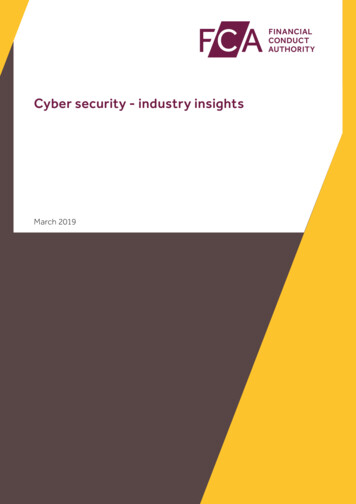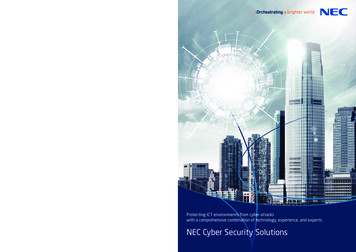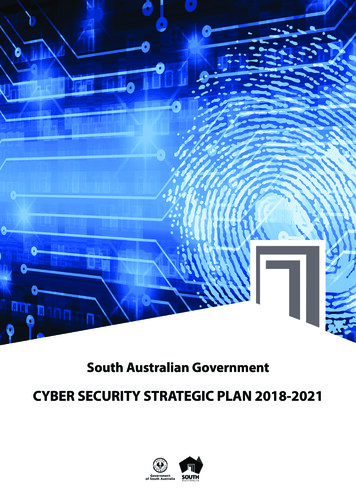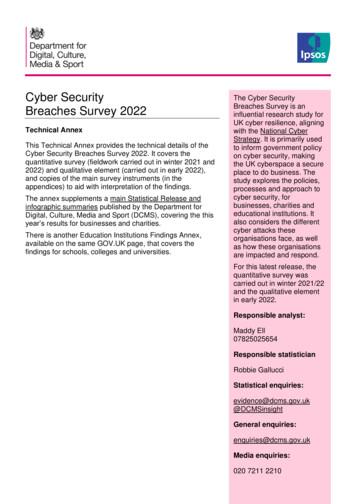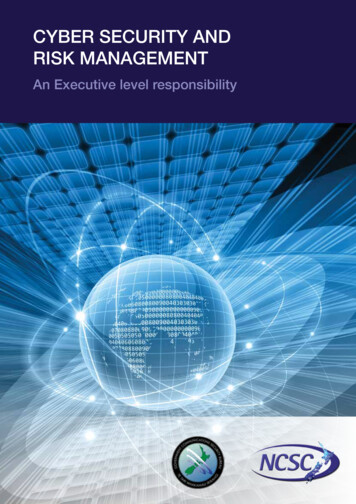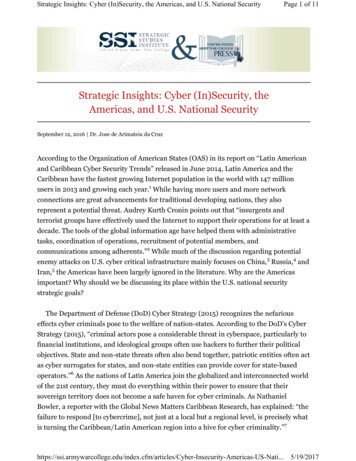
Transcription
Strategic Insights: Cyber (In)Security, the Americas, and U.S. National SecurityPage 1 of 11Strategic Insights: Cyber (In)Security, theAmericas, and U.S. National SecuritySeptember 12, 2016 Dr. Jose de Arimateia da CruzAccording to the Organization of American States (OAS) in its report on “Latin Americanand Caribbean Cyber Security Trends” released in June 2014, Latin America and theCaribbean have the fastest growing Internet population in the world with 147 millionusers in 2013 and growing each year.1 While having more users and more networkconnections are great advancements for traditional developing nations, they alsorepresent a potential threat. Audrey Kurth Cronin points out that “insurgents andterrorist groups have effectively used the Internet to support their operations for at least adecade. The tools of the global information age have helped them with administrativetasks, coordination of operations, recruitment of potential members, andcommunications among adherents.”2 While much of the discussion regarding potentialenemy attacks on U.S. cyber critical infrastructure mainly focuses on China,3 Russia,4 andIran,5 the Americas have been largely ignored in the literature. Why are the Americasimportant? Why should we be discussing its place within the U.S. national securitystrategic goals?The Department of Defense (DoD) Cyber Strategy (2015) recognizes the nefariouseffects cyber criminals pose to the welfare of nation-states. According to the DoD’s CyberStrategy (2015), “criminal actors pose a considerable threat in cyberspace, particularly tofinancial institutions, and ideological groups often use hackers to further their politicalobjectives. State and non-state threats often also bend together, patriotic entities often actas cyber surrogates for states, and non-state entities can provide cover for state-basedoperators.”6 As the nations of Latin America join the globalized and interconnected worldof the 21st century, they must do everything within their power to ensure that theirsovereign territory does not become a safe haven for cyber criminals. As NathanielBowler, a reporter with the Global News Matters Caribbean Research, has explained: “thefailure to respond [to cybercrime], not just at a local but a regional level, is precisely whatis turning the Caribbean/Latin American region into a hive for cyber ex.cfm/articles/Cyber-Insecurity-Americas-US-Nati. 5/19/2017
Strategic Insights: Cyber (In)Security, the Americas, and U.S. National SecurityPage 2 of 11Jane Fraser, CEO of Citigroup Latin America, also states that over half the populationin Latin America and the Caribbean is online, and that the rate of growth in Internet useis among the highest in the world.8 Particularly troubling regarding cybersecurity in theAmericas is the fact that as more people join the information superhighway, the Americasstill lack any cybersecurity strategies or critical infrastructure plans. Again, as Fraserpoints out, “cybercrime in Latin America and the Caribbean is estimated to be close to 90 billion a year. Yet 80 percent of the countries in the region do not have cybersecuritystrategies or critical infrastructure plans. Sixty-six percent do not have the resources orexpertise.”9 Cybercrime in the Americas not only undermines the democratic progressachieved thus far, but it could also harm economic growth. Jane Fraser notes that“combating cybercrime and strengthening cyber resilience are imperative to economicand social development and should be considered a critical cornerstone of domestic andforeign policy.”10In the traditional view of political realism, the nation-state is the primary unit ofanalysis and a sovereign hegemon. However, in the cyberworld of the 21st century, theInternet is seen as the realization of the classic international relations theory of ananarchic, leaderless world.11 The cyberworld of the 21st century could be argued as theequivalent of a Hobbesian state of nature. Given that most countries in the Americas donot have cybersecurity strategies or critical infrastructure plans, the Americas could beused by terrorist organizations and transnational organized crime cartels to launch anattack on U.S. critical infrastructure. Former Chairman of the Joint Chiefs of Staff, ArmyGeneral Martin E. Dempsey, stated that “the spread of digital technology has not beenwithout consequences. It has also introduced new dangers to our security and oursafety.”12In the new wars of the 21st century, the use of cyberpower in conjunction with kineticmilitary power will be a force multiplier. The Internet has become an essential componentof terrorists' information operations (IOs) designed to achieve offensive strategicobjectives, as future conflicts in the 21st century extend from the physical domain intocyberspace. In his “International Strategy for Cyberspace,” President Obamaacknowledged that “cybersecurity threats can even endanger international peace andsecurity more broadly, as traditional forms of conflict are extended into cyberspace.”13 Insecret and without fear of retaliation, Jihadist groups and terrorist organizations areusing the Internet as a tool to conduct cyberplanning—“the digital coordination of anintegrated plan stretching across geographical boundaries that may or may not result inbloodshed.”14 Within the realm of Latin America and the Caribbean, as the Internetbecomes an integral part of the globalized international system, the two “monstercountries” Brazil and Mexico cannot be rticles/Cyber-Insecurity-Americas-US-Nati. 5/19/2017
Strategic Insights: Cyber (In)Security, the Americas, and U.S. National SecurityPage 3 of 11Map 1. Brazil and its Neighbors.In his book Around the Cragged Hill: A Personal and Political Philosophy, the lateGeorge F. Kennan explains that a “monster country” is a country endowed with anenormous territory and population.15 The characterization of Brazil as a “monstercountry” places Brazil in the same category of nations such as China, Britain, the UnitedStates, and Japan. A monster country is endowed with the following characteristics:continental territorial dimensions and a population of more than 150 million people, atradition of economic development, and a diverse foreign trade policy. Brazil, the sleepinggiant of South America, occupies half of the continent and is the fifth most populouscountry in the world with an estimated population of about 205 million people. Eightyfour percent of the Brazilian population is heavily concentrated in urban centers,especially São Paulo and Rio de Janeiro. Approximately 22 million Brazilians werevictims of cybercrimes in 2012, and that number continues to grow. This large number ofcyber-victimization occurs despite advanced capabilities in cybersecurity and deterringcybercrime, with numerous state institutions and agencies playing active roles. Even withthese attempts of combating traditional crimes and cybercrime within the state, Brazilstill expresses concern with criminalizing cyber offenses. The lack of a cohesivecorresponding legal framework that would address these various offenses inhibits theprosecution of those who commit recognized cybercrimes. Another major concernregarding Brazil is its geographical proximity to the Tri-Border Area icles/Cyber-Insecurity-Americas-US-Nati. 5/19/2017
Strategic Insights: Cyber (In)Security, the Americas, and U.S. National SecurityPage 4 of 11Map 2. The Tri-Border Region in Latin America is composed of the cities ofCiudad del Este, Alto Paraná; Puerto Iguazú, Misiones; and Foz do Iguaçu,Paraná.According to Peter J. Meyer, there are no “known operational cells of [al-Qaeda] orHezbollah related groups in the Western Hemisphere; however, the United Statesremains concerned that proceeds from legal and illegal goods flowing through the TBAcould potentially be diverted to support terrorist groups.” 16 For example, in December2010, the U.S. Treasury Department sanctioned Hezbollah’s chief representative in SouthAmerica, Bilal Mohsen Wehbe, for transferring funds collected in Brazil to a Hezbollahgroup in Lebanon.17 The ability of potential enemies of the United States to operatewithout impunity within the TBA could result in an attack against the U.S. homeland’scritical infrastructure. This is particularly troubling since, despite known activities bypotential enemies, the Brazilian government has yet to adopt legislation to maketerrorism financing an autonomous offense.18 Max G. Manwaring, the former GeneralDouglas MacArthur Chair and emeritus professor of Military Strategy at the U.S. ArmyWar College, argues that “gangs are half-political and half-criminal nonstate actors thatactually and potentially pose a dominant, complex emergency threat in a securityenvironment in which failing states flourish.”19Mexico is the second “monster country” in the Americas which, due to its ongoing gangrelated violence and drug trafficking, represents another major concern for U.S. nationalsecurity in the Internet age. Mexico has an estimated population of approximately 122million people, with 76 percent of its population living in urban centers, mainly m/articles/Cyber-Insecurity-Americas-US-Nati. 5/19/2017
Strategic Insights: Cyber (In)Security, the Americas, and U.S. National SecurityPage 5 of 11Map 3. Central Intelligence Agency, Fact Book. Available es/the-worldfactbook/geos/mx.html.The rising levels of hacktivism throughout the world are staggering, and Mexico hasbeen ranked “as one of the world’s most vulnerable countries to cyberattacks.”20 It saw anestimated 40 percent21 increase and a staggering 113 percent increase in the number ofcybercrime incidents in 2012 and 2013, respectively. Cartels, a longitme concern for theMexican government, have embraced the Internet to recruit new members, completetransactions, and search for newer and more targets to exploit.22Likewise, the proliferation and anonymity of the Internet fosters hacktivist recruitmentfor groups such as Anonymous and improves their ability to escape prosecution.Combined with perceived declines in social and economic conditions, hacktivism is likelyto increase. Specifically, situations such as the retaliatory kidnapping of a hacker with thegroup Anonymous, who threatened the Los Zetas cartel and their cohorts withcybertactics, will be more likely. Prioritization of cyberthreats has yet to rise like the othernational security concerns that result from the environment along the U.S.-Mexicoborder, such as that of traditional cartel violence and corruption among Mexican lawenforcement officials.23In the U.S., the DoD designated cyberspace as a new domain of warfare in 2011. Thiselevation in strategic importance makes cyberspace comparable to land, sea, air, or outerspace as a new battle frontier. The U.S. government and its armed forces recognizecyberspace as a potential future battleground. Former Defense Secretary Leon Panettahas publicly stated that “cyberspace is the new frontier, full of possibilities to advancesecurity and prosperity in the 21st century. And yet, with these possibilities, also comenew perils and new dangers.”24 Former Chairman of the Joint Chiefs of Staff ArmyGeneral Martin E. Dempsey stated that “the Department of Defense is adding a newmission: defending the nation, when asked, from attacks of significantconsequence—those that threaten life, limb, and the country’s core criticalinfrastructure.”25 For international jihadists, the Internet has become without a shadowof a doubt the most cost-effective means of delivering its messages worldwide,coordinating attacks and, most importantly, allowing jihadist organizations to ticles/Cyber-Insecurity-Americas-US-Nati. 5/19/2017
Strategic Insights: Cyber (In)Security, the Americas, and U.S. National SecurityPage 6 of 11without leaving the confines of their safe havens. Jihadist groups and terroristorganizations are using the Internet as a tool to carry out their “cyberplanning” in secretand without fear of retaliation. Lieutenant Colonel Timothy L. Thomas, an analyst at theForeign Military Studies Office in Fort Leavenworth, Kansas, defines “cyberplanning” as“the digital coordination of an integrated plan stretching across geographic boundariesthat may or may not result in bloodshed.”26Cyberwar in the “hacked world order”27 of the 21st century is much like Carl vonClausewitz’s view of war as “a true chameleon that slightly adapts its characteristics to thegiven cases.”28 Given the problem of attribution and the ability of hackers or organizedcriminal organizations to route their attacks, Henry Kissinger argues in his book WorldOrder, that “cyberspace challenges all historical experiences. . . . The threats emergingfrom cyberspace are nebulous and undefined and may be difficult to attribute.”29 TheInternet is becoming an integral part of the globalized international system, part of the“new wars . . . in which the difference between internal and external is blurred; they areboth global and local and they are different both from classic inter-state wars and classiccivil wars.”30 In the globalized world of the 21st century, nation-states and violent nonstate actors (VNSAs) alike will make use of the power of technology to advance theiractivities without fear of retaliation, prosecution, or concern from geographicalboundaries.31In Latin America, governments have become extremely concerned about theproliferation of the Internet as a force multiplier in the commission of a crime. Forexample, governments in Latin America are concerned with the “criminal practices ofindividuals and crime networks connected to cyberspace with the intention of makingillicit economic gains. Common examples range from e-banking scams to drug traffickingand child pornography.”32 The prevalence of drug trafficking increases in relation to “the[Internet emerging] as a critical interface in the selling and purchasing of all manner ofcommodities, including both prescription and illicit narcotics . . . drug profits are oftenlaundered through the Internet through the purchasing of goods and services and thetransferring of cash.”33 In the new brave world of the 21st century, a “new criminality” isemerging in cyberspace. The world of “the Internet and related social media tools havenot just empowered citizens to exercise their rights, but also enabled and extended thereach of gangs, cartels, and organized criminals.”34Given the Hobbesian nature of cyberspace, what can the United States Governmentand its Army do to assist the nations of Latin America in their struggle against hacktivismand cybercriminals and therefore prevent a potential enemy from attacking U.S. criticalinfrastructure? First, the U.S. Department of Defense and its cybersecurity organizations(U.S. Cyber Command, Army Cyber Command, Navy Cyber Forces, and Air icles/Cyber-Insecurity-Americas-US-Nati. 5/19/2017
Strategic Insights: Cyber (In)Security, the Americas, and U.S. National SecurityPage 7 of 11Cyber/24th Air Force) must do everything within their power to stop or at least mitigatethe consequences of Distributed Denial of Service (DDoS) attacks against the homeland’scritical infrastructure.Second, the U.S. Government should shore up international support for the BudapestConvention on Cybercrime and other multilateral cybersecurity arrangements including,but not limited to: the International Telecommunications Union’s World Summit on theInformation Society (WSIS) and the Global Cybersecurity Agenda (GCA), the Asia-PacificEconomic Cooperation (APEC), the European Network and Information Security Agency(ENISA), the Computer Emergency Response Pre-Configuration Team (CERT-EU), andthe North Atlantic Treaty Organization (NATO)-Russia Council. This is an important stepthat should be taken by the U.S. Government and its cybersecurity agencies since thedigital world routinely ignores national and international boundaries.Third, the U.S. Government should provide the developing world with technical andforeign aid assistance tied to the development of cyber investigation methods, cybertraining, cyber policing, and law enforcement cooperation and assistance. The U.S. shouldassist the developing world as it joins cyberspace as a latecomer. Perhaps the U.S.Government should create a Cyber Marshall Plan for the developing world similar to theMarshall Plan created for Europe in the aftermath of World War II; when criticalinfrastructures were destroyed, the Marshall Plan helped in the reconstruction of Europe.The U.S. Government cannot afford to allow the developing world to become a conduit forcyberattacks against the homeland’s critical infrastructure.Fourth, the U.S. Government must continue to invest in its cyber workforce despitebalanced budget disputes and sequestration. As Frank J. Cilluffo, Director of the GeorgeWashington University Homeland Security Policy Institute, and Sharon L. Cardash,Associate Director at the Homeland Security Policy Institute, have stated: “there is nosubstitute for a human source (HUMINT). Collecting and exploiting all-sources ofintelligence is therefore the most robust way forward, even in the cyber realm.”35Finally, the U.S. Government and its federal agencies must engage the private sector ina conversation regarding their shared responsibility and accountability for the exchangeof information about cyberthreats and cyberterrorism via the Internet. Former Chairmanof the Joint Chiefs of Staff Army General Martin E. Dempsey publicly acknowledged that“sharing information about cyberthreats is one of the most important ways to strengthencybersecurity across the private sector, but threat information primarily is shared in onlyone direction: from the government to critical infrastructure x.cfm/articles/Cyber-Insecurity-Americas-US-Nati. 5/19/2017
Strategic Insights: Cyber (In)Security, the Americas, and U.S. National SecurityPage 8 of 11In his book, Brave New War: The Next Stage of Terrorism and the End ofGlobalization, John Robb argues that “we have entered the age of the faceless, agileenemy. From London to Madrid to Nigeria to Russia, stateless terrorist groups haveemerged to score blow after blow against us.”37 Therefore, to ignore the WesternHemisphere could result in damaging consequences to the national security of the U.S.,its allies, and national critical infrastructure. As Martin Van Creveld in his seminal book,The Transformation of War: the most radical reinterpretation of armed conflict sinceClausewitz, points out: “in the future, war will not be waged by armies but by groupswhom we today call terrorists, guerrillas, bandits, and robbers, but who will undoubtedlyhit on more formal titles to describe themselves.”38ENDNOTES1. Symantec and The Organization of American States et al., “Latin American and CaribbeanCybersecurity Trends,” Report, Washington, DC: Organization of American States Secretariat forMultidimensional Security, June 2014, available se/other resources/b-cyber-security-trendsreportlamc.pdf, accessed on October 1, 2015.2. Audrey Kurth Cronin, “How Global Communications Are Changing the Character of War,” TheWhitehead Journal of Diplomacy and International Relations, Winter-Spring 2013, Vol. 14, Iss. 1, pp. 2539.3. Igor Bernik, Cybercrime and Cyberwarfare, New York: Wiley, 2014; Daniel Ventre, ed., ChineseCybersecurity and Defense, New York: Wiley, 2014.4. Greg Austin, “Russia’s Cyber Power,” EastWest.ngo Commentary, October 26, 2014, available wer.5. Lieutenant Colonel Eric K. Shafa, “Iran’s Emergence as a Cyber Power,” Of Interest Article, StrategicStudies Institute, U.S. Army War College, August 20, 2014, available 014/08/20.6. U.S. Department of Defense (DoD), The DoD Cyber Strategy, Washington, DC: U.S. Department ofDefense, April 2015, available from 5 cyberstrategy/Final 2015 DoD CYBER STRATEGY for web.pdf, accessed on October 1, 2015.7. Nathaniel Bowler, “Cyber Crime and Critical Infrastructure in the Americas: Only as Strong as theWeakest Link,” Global News Matters, Caribbean News, entry posted May 6, 2014, available weakest-link/, accessed on October 1, 2015.8. Jane Fraser, “Promote Americas-wide Collaboration on Cybersecurity,” Quarterly Americas, Vol. 10,Iss. 4, 2016, p. es/Cyber-Insecurity-Americas-US-Nati. 5/19/2017
Strategic Insights: Cyber (In)Security, the Americas, and U.S. National SecurityPage 9 of 119. Ibid., p. 92.10. Ibid.11. Eric Schmidt and Jared Cohen, The New Digital Age: Reshaping the Future of People, Nations andBusiness, New York: Alfred A. Knopf, 2013.12. Claudette Roulo, American Forces Press Service, “DOD Must Stay Ahead of Cyber Threat, DempseySays,” DoD News, June 27, 2013, available from d 120379.13. Barack Obama, International Strategy for Cyberspace: Prosperity, Security, and Openness in aNetworked World, Washington, DC: The White House, May 2011.14. Timothy L. Thomas, “Al Qaeda and the Internet: The Danger of ‘Cyberplanning’,” Parameters, Vol.XXXIII, No. 1, Spring 2003, pp. 112–23, available /parameters/Articles/03spring/thomas.pdf.15. George F. Kennan, Around the Cragged Hill: A Personal and Political Philosophy, New York: W. W.Norton, 1993, p. 143.16. Peter J. Meyer, Congressional Research Service Report for Congress: Brazil: Political andEconomic Situation and U.S. Relations, No. RL33456, Washington, DC: U.S. Library of Congress,Congressional Research Service, March 27, 2014.17. Ibid.18. Ibid.19. Max G. Manwaring, Street Gangs: The New Urban Insurgency, Carlisle, PA: Strategic StudiesInstitute, U.S. Army War College, March 2005, available pubs/display.cfm?pubID 597.20. Rebecca Conan, “Defending Mexico’s Critical Infrastructure Against Threats,” The ReportCompany, July 22, 2013.21. Trend Micro and The Organization of the American States, Latin American and CaribbeanCybersecurity Trends and Government Responses, Washington, DC: Organization of the American StatesSecretariat for Multidimensional Security, May 2013, p. 7, available ent-responses.pdf.22. José Abreu, “Mexican Drug Cartels and Cyberspace: Opportunity and Threat,” InfoSec Institute,entry posted March 21, 2012, available from els/; articles/Cyber-Insecurity-Americas-US-Nati. 5/19/2017
Strategic Insights: Cyber (In)Security, the Americas, and U.S. National SecurityPage 10 of 1123. With corruption reaching even the federal levels, law enforcement has been monitoring and purgingcorrupted officers since 2005. See Ted Galen Carpenter, “Corruption, Drug Cartels, and the MexicanPolice,” The National Interest, September 4, 2012, available ion-drug-cartels-the-mexican-police-7422.24. U.S. DoD Press Operations, “Remarks by Secretary Panetta on Cybersecurity to the BusinessExecutives for National Security, New York City,” News Transcript, October 11, 2012, available ipt.aspx?transcriptid 5136.25. Roulo.26. Thomas, pp. 112–23.27. Adam Segal, The Hacked World Order: How Nations Fight, Trade, Maneuver, and Manipulate inthe Digital Age, New York: PublicAffairs, 2016.28. Carl von Clausewitz, On War, trans. by Michael Howard and Peter Paret, New York: OxfordUniversity Press, 2008, p. 30.29. Henry Kissinger, World Order, New York: Penguin Press, 2014, p. 344.30. Mary Kaldor, New and Old Wars: Organized Violence in a Global Era, 3rd ed., Redwood City, CA:Stanford University Press, 2012, p. vi.31. Jose de Arimateia da Cruz and Taylor Alvarez, “Cybersecurity Initiatives in the Americas:Implications for U.S. National Security,” Marine Corps University Journal, Vol. 6, No. 2, Fall 2015, p.60.32. Gustavo Diniz and Robert Muggah, A Fine Balance: Mapping Cyber (In)Security in Latin America,Strategic Paper 2, Rio de Janeiro, Brazil: Igarapé Institute, June 2012, p. 15.33. Ibid.34. Ibid.35. Frank J. Cilluffo and Sharon L. Cardash, “Cyber Domain Conflict in the 21st Century,” TheWhitehead Journal of Diplomacy and International Relations, Vol. 14, No. 1, Winter-Spring 2013, p. 4147.36. Roulo.37. John Robb, Brave New War: the next stage of terrorism and the end of globalization, New York:John Wiley & Sons, Incorporated, 2007, p. 3.38. Martin Van Creveld, The Transformation of War: the most radical reinterpretation of armedconflict since Clausewitz, New York: The Free Press, 1991, p. les/Cyber-Insecurity-Americas-US-Nati. 5/19/2017
Strategic Insights: Cyber (In)Security, the Americas, and U.S. National SecurityPage 11 of 11*****The views expressed in this Strategic Insights piece are those of the author and do notnecessarily reflect the official policy or position of the Department of the Army, theDepartment of Defense, or the U.S. Government. This article is cleared for public release;distribution is unlimited.*****Organizations interested in reprinting this or other SSI and USAWC Press articles shouldcontact the Editor for Production via email at SSI Publishing@conus.army.mil. Allorganizations granted this right must include the following statement: “Reprinted withpermission of the Strategic Studies Institute and U.S. Army War College Press, U.S. ArmyWar m/articles/Cyber-Insecurity-Americas-US-Nati. 5/19/2017
and Caribbean Cyber Security Trends" released in June 2014, Latin America and the . The Department of Defense (DoD) Cyber Strategy (2015) recognizes the nefarious effects cyber criminals pose to the welfare of nation-states. According to the DoD's Cyber Strategy (2015), "criminal actors pose a considerable threat in cyberspace .
